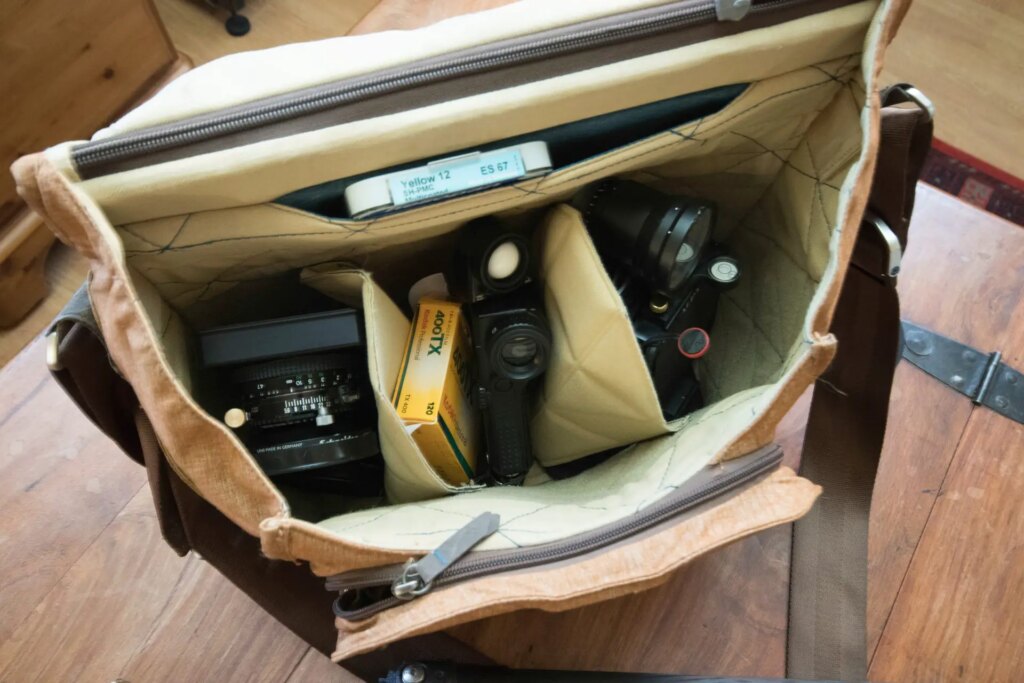
Ready to go in an airport cabin friendly bag, my Alpa 12 TC with a Super Angulon 47mm Lens, a trusty Sekonic spot meter, a Yellow Filter and tripod.
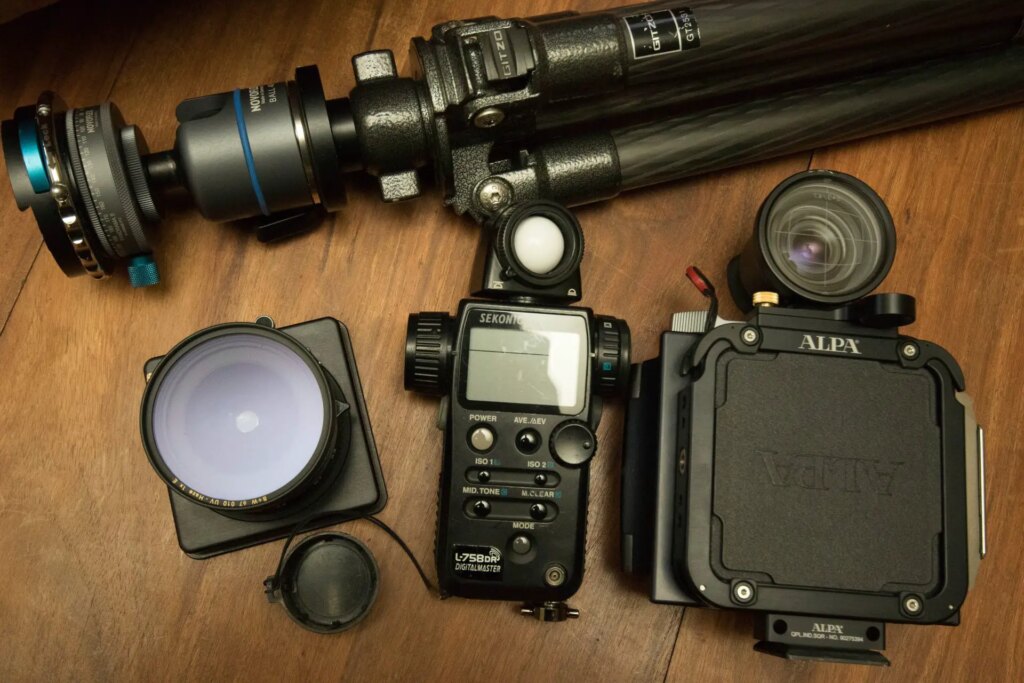
Composing images with the Alpa is through a lovely big ‘Cyclops’ style central finder. The lens is really wide by medium format terms. It approximates to 18mm on a 35mm camera. It has frame lines for composition and after that I generally opt for hyperlocal distance focusing. There is a nice spirit level visible though the finder. This is essential because it is very easy to distort perspective shooting this wide if not absolutely level. Ideally, I want to stop my lens down to f11 or f16 which gives me everything sharp from 1 or 2m to infinity. It is possible to focus accurately with a ground glass back or even a laser tape measure, but this means carrying more clutter and slows down the process. For super wide lenses it is hassle for very little gain.
Reliant on small apertures for focusing I planned that I would need ISO 400 film for February light levels with shutter speeds generally around 1/15 to 1/30 of a second. I wanted to avoid overly long exposures as people become too blurred or disappear altogether. There is no reflex mirror so lovely vibration free exposures are easy but none of your image stabilisers either. A wide lens and no vibration can be handheld if needed. Alpa lenses have a nice brass shutter button threaded onto the lens barrel. No cable release to foul things up. It is a very simple set up reliant on good ergonomics, great viewfinder and optics, and nothing to confuse or irritate me. All the things that are not here are what is really great about it.
We departed with a nice crisp box of 5 rolls of Kodak Tri-X and a few rolls of slower film purely to treat my anxiety about the remote possibility of unexpectedly Tri-X-vapourising light levels. I thought about packing some colour film but the whole place is made of squares of bolted together concrete and metal, and the sky is generally a smooth light grey with very small smudges of cloud. Polarising filter? Nothing to polarize. There is very little haze. Grey graduation filter? Nothing to filter. It is all grey. The exposures are very even in just about any direction. It is as though some massive spectral soft boxes have been set up conveniently off camera. One issue with very wide lenses is that they are prone to uneven exposures given their coverage. No such problem here in February. It is great light for monochrome enthusiasts.
Whilst we were in Berlin, there was an exhibition of William Egglestone’s brilliant Kodachrome Dye Sublimation prints of the Southern US in the 1950s. Hailed as the master of Colour Photography as an art form, I would highly recommend it if you ever get the chance to see some of Egglestone’s work. A few shots from his visit to Berlin were included, but starved of vivid colour, to me, they looked anaemic next to his more iconic pictures. Berlin in February is definitely a monochrome place.
There is a lot of cold-war era fiction based around Berlin. In all the books that I have read the spies usually meet in Alexander Platz. I am not sure why. Surely, they would be very likely to bump into agents working for ‘the other side’? I am not sure if it is a good place for spies, but it is a good place to start taking pictures. The light when I was there did not change all that much and there were good shooting opportunities throughout most of the day.
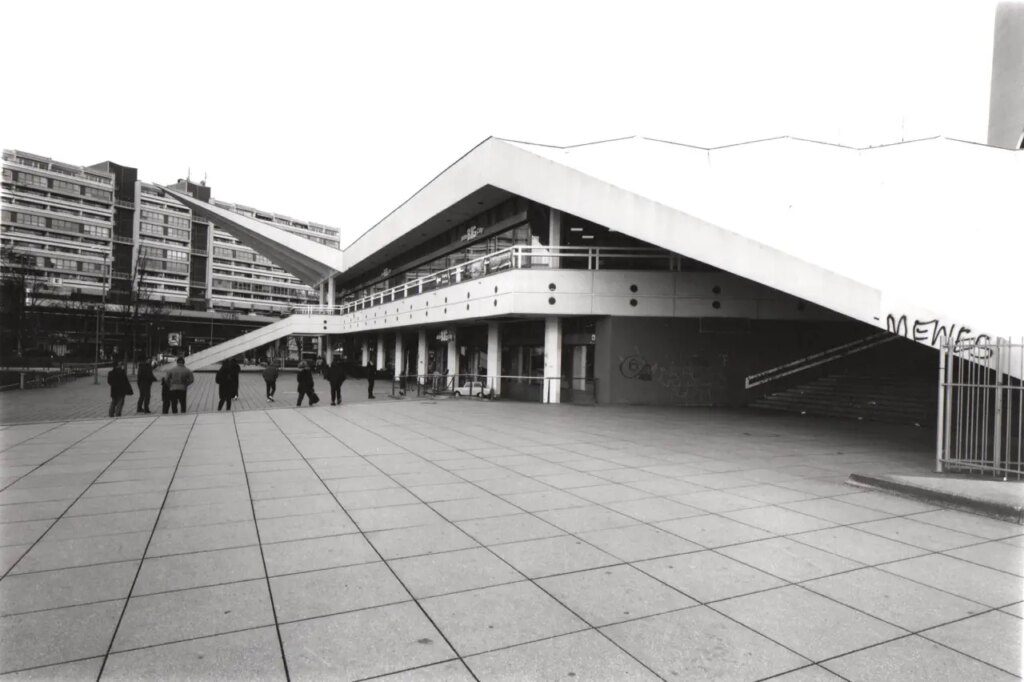
The middle of Alexanderplatz is dominated by the 203m high TV Tower which is a major tourist feature. At the base of the tower is a huge concrete base with four acutely angled corners like the jaws of some huge concrete dinosaur. There are two layers of restaurants and coffee bars in the ‘belly’ of the beast but in February it did not seem to have caught many tourists. A trip up to the top of the tower would cost a family of four around 100 Euros. Maybe that was scaring some people away. Taking a few pictures of the lovely angled corners it was possible to get a nice stretch of plinth with the jaws looking as though they are about to crunch a block of flats. The base of the tower is visible just in the top right hand corner. Keeping the camera level has produced a lot of for ground but I quite like the lead in lines from the paving stones. Being medium format these 6×9 images can be cropped quite nicely but I always print full frame and live with it for a while before any sort of image surgery.
Another shot of the square shows some very cold and uncomfortable metal benches and a few people contemplating the 26 euro per person ride in the tower. Its base is visible in the left hand top corner. I really did not want to shoot the whole tower. It would be easier to buy a postcard.
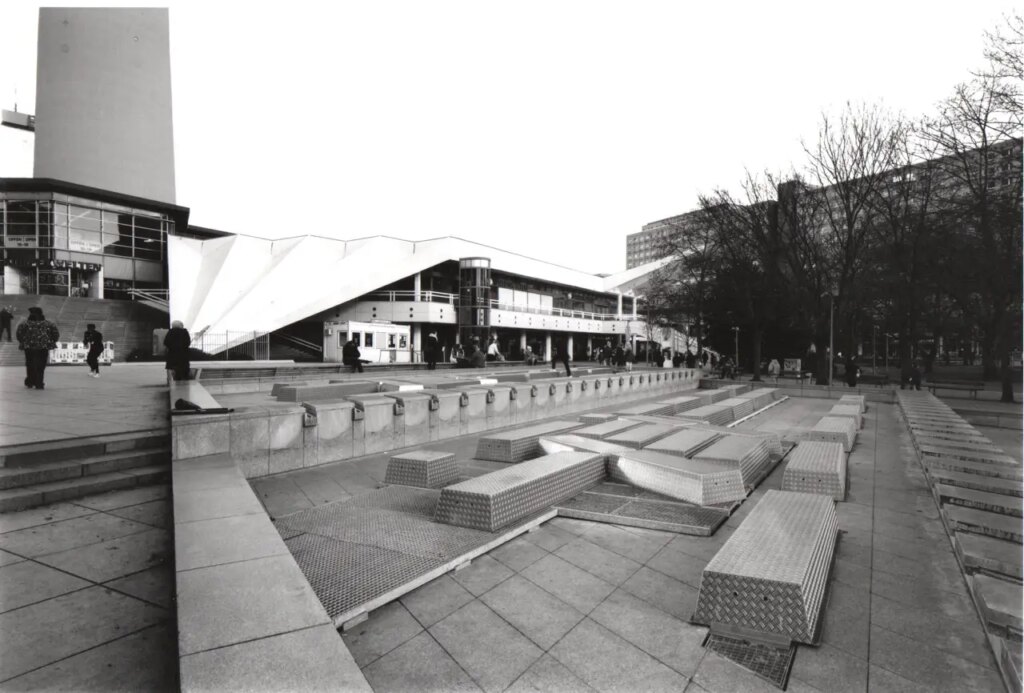
The monster is contemplating swallowing a whole tree. A little upward tilt of the lens to get everything in has caused some slight convergence of the building sides but it adds to the effect of the two gaping triangles. The concrete is looking a bit tired. It must have been very exciting when it emerged in the late 1960s East Germany.
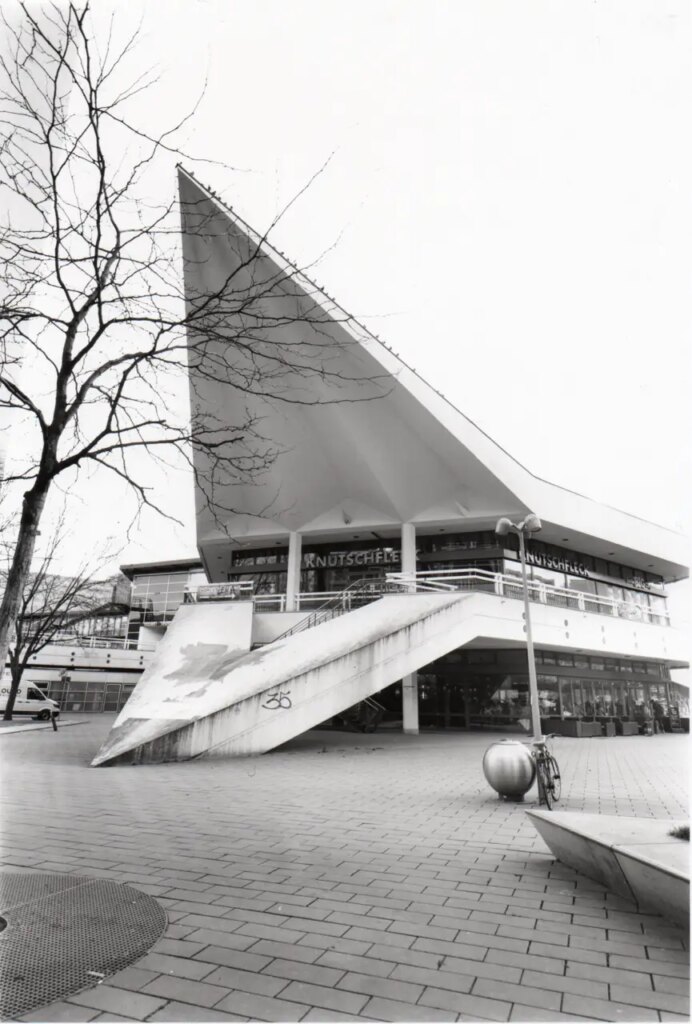
Walking away from the main square there is a nice view of the glass domed roof covering the Alexanderplatz station. The railway bridge has a shady underpass which attracts some colorful characters even in monochrome. Maybe this is where the spies meet? Lots of overhead power lines fan out from the station and the light levels are such that I easily captured them against the sky metering the exposure from the convenient neutral grey cobble stones. Tram lines run along-side the station, curve and disappear under the bridge. Shooting at around 1/15 second there is a bit of movement in pedestrians. I am pleased with how much detail I have captured. It is a picture in various layers. I am sure it needs to be printed really big. Berlinners show very little interest in my camera and I was able to capture images with people enjoying the city. I did not feel as though I was in anyone’s way.
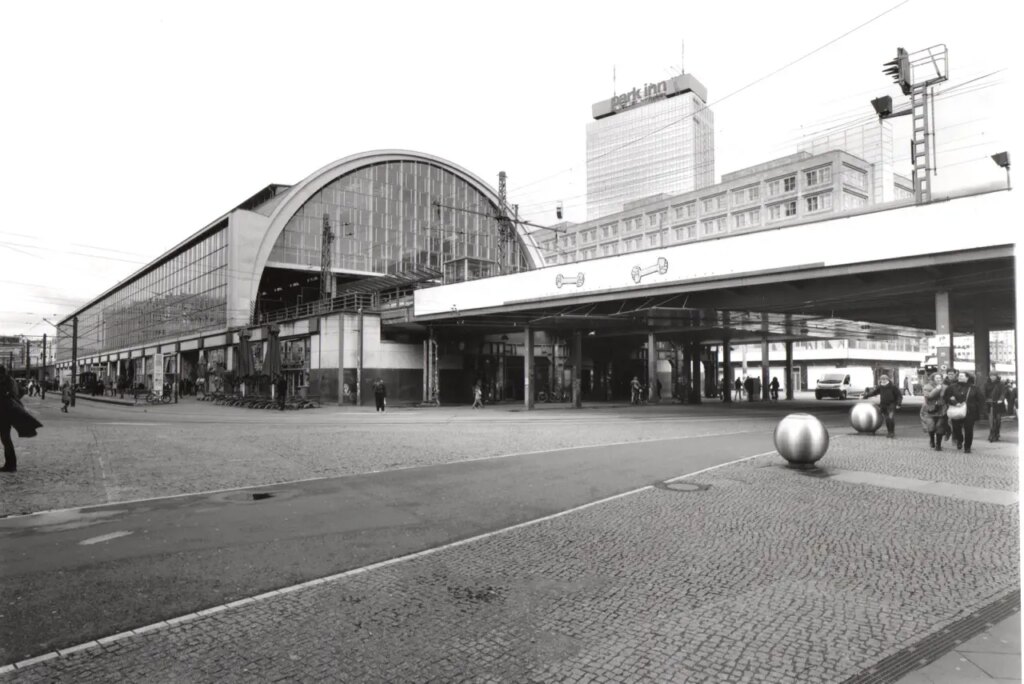
Passing under the railway bridge a load of bikes stand right of the tram lines, and behind them is the 24 sided Berlin World Clock. It is a popular gathering place and city landmark. There is an interesting solar system mobile on the top but it is not a highly scientific clock. It used to run on a Trabant gear box.
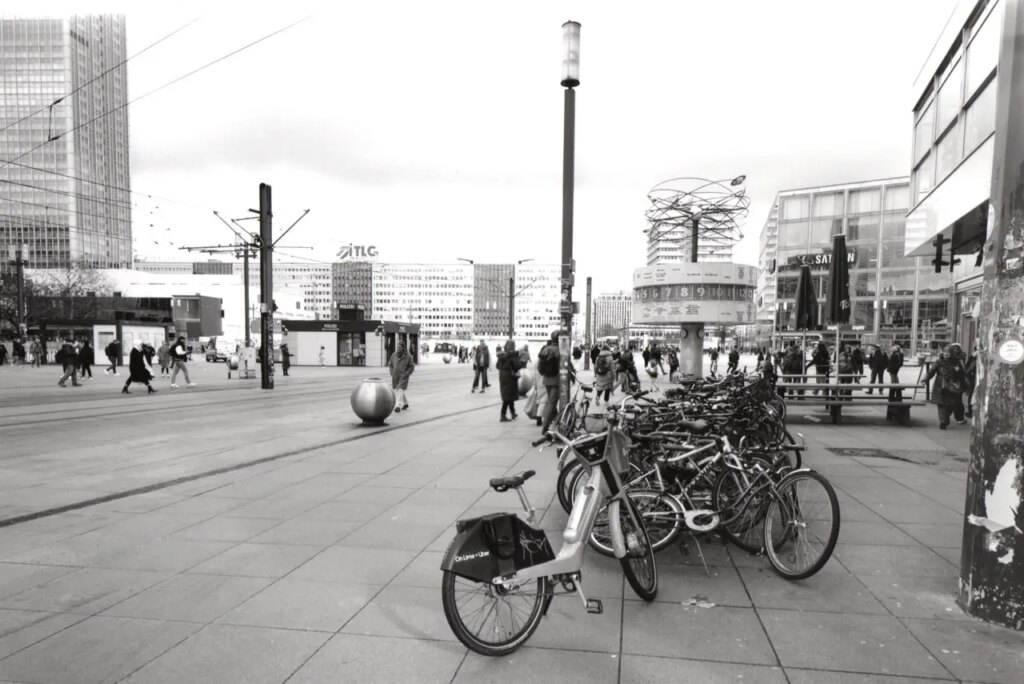
This picture was taken hand-held at around 1/15 second in a quick moment avoiding groups of people taking ‘selphies’.
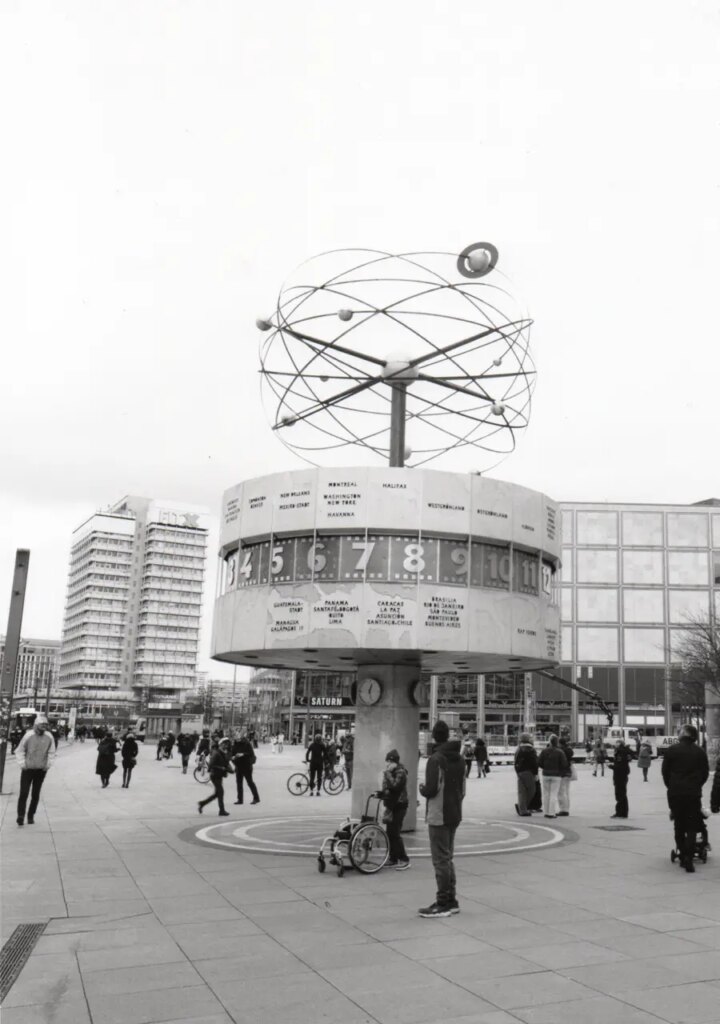
Heading up into the station past a load of very tempting take-aways and Kebab stalls I wandered the full length of the platform. The platform end was enveloped by a plethora of converging lines in every direction. Perfect wide angle territory. Again, the scene falls into layers, with the trams under the bridge, rails converging from both sides of the central platform and typical lattices of concrete buildings, and some over-head power lines. Detail is just visible under the bridge and the tiniest wash of cloud that could be mistaken for a stain on the film. The converging parallel lines are nice and straight with very little angular distortion. The perspective looks fairly natural, even though it a wide angle shot. There is a distant train. I did contemplate including trains a bit closer, but they tended to overpower the composition destroying the symmetry of it all.
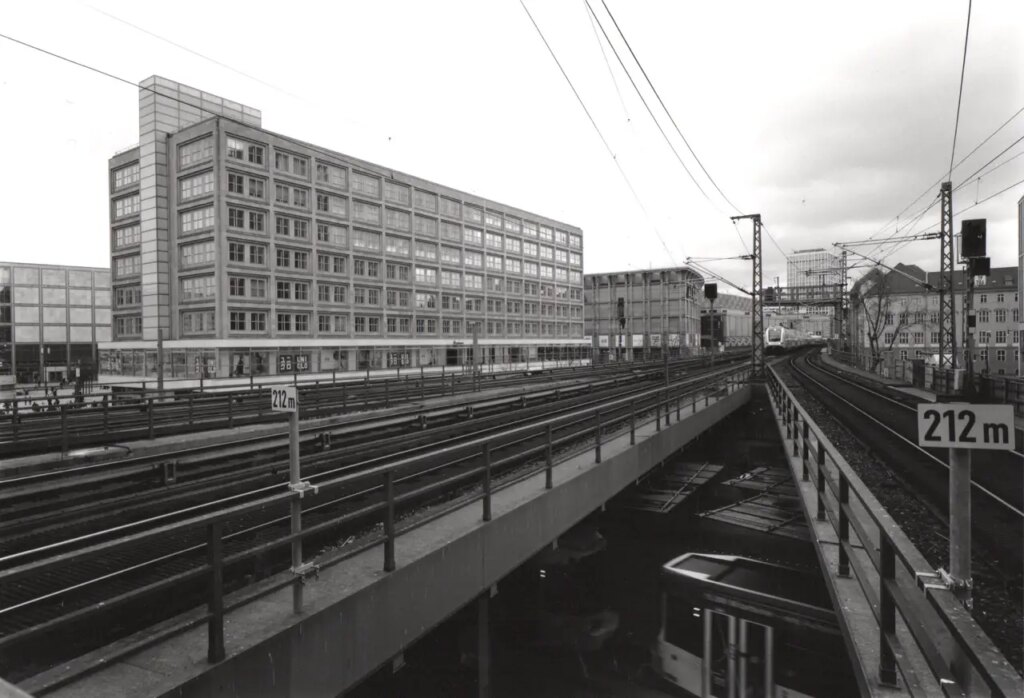
Walking the length of the platform in the other direction I am rewarded by more light. A pylon in the foreground is sharp enough close up with an aperture of F16. A nice triangle of rails in this composition provides a viewing window onto the road below. The gently curving rails to the left are nicely lit. Lots of different textures of concrete somehow cobbled together gives plenty of interest.
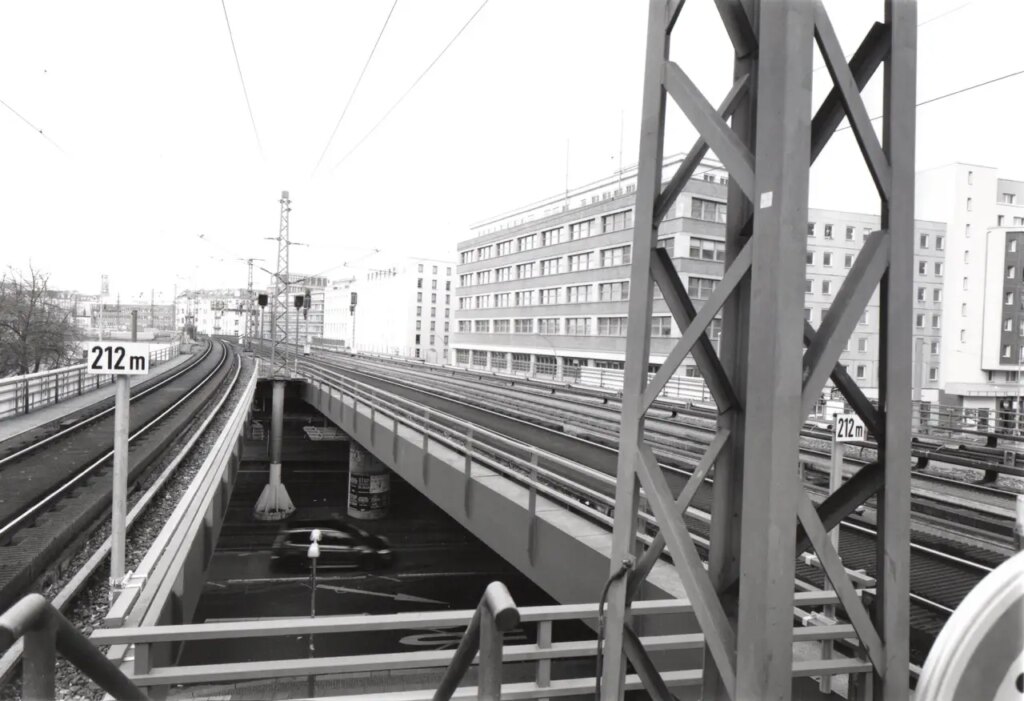
Rotating the tripod clockwise to miss out the pylon gives me nice foreground of rails with the street and buildings in the layer behind. The bright metal rails caught my attention contrasting with the dark sleepers. Almost like a liquorice all-sort. A heating pipe snakes down from a partially demolished building. Cars and people in the city scape are visible on the streets below. Lots of things are going on in this image. I like the overall impact but there is plenty more on close inspection. Again, I already want to print this one big big big!
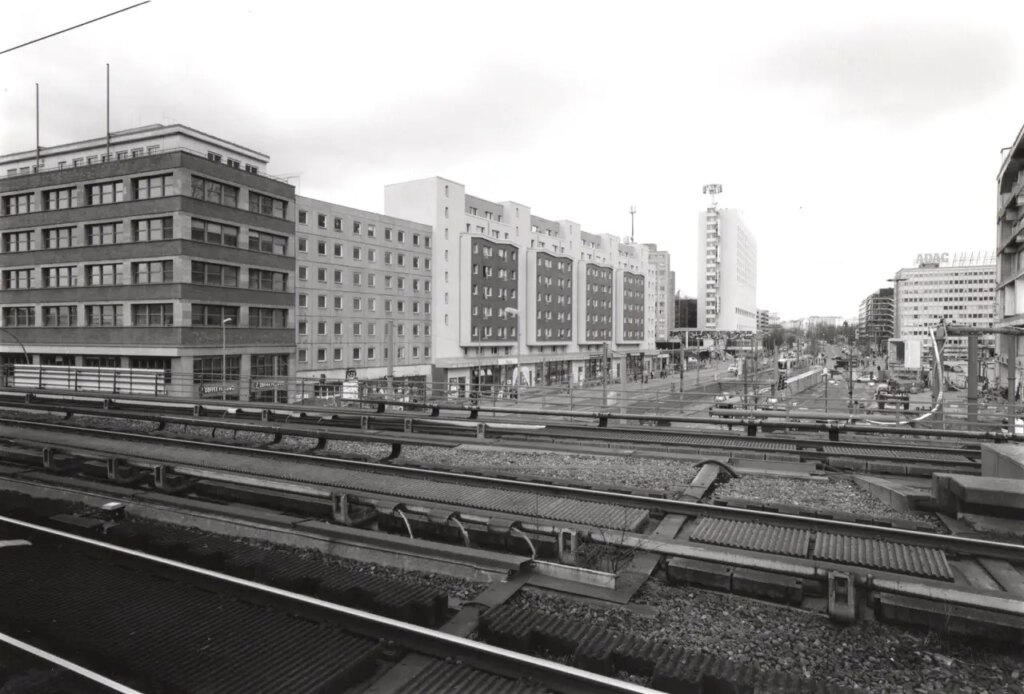
A must see is the Brandenburg gate. Getting centered and level was vital for this image. I am not sure if it is visible on screen but the face of the charioteer and horses heads are incredibly sharp with lots of detail on the negative. I am still getting nice exposures 1/15 second and f16 in any direction. Maybe this is the Berlin ‘Unsunny 16 rule’!
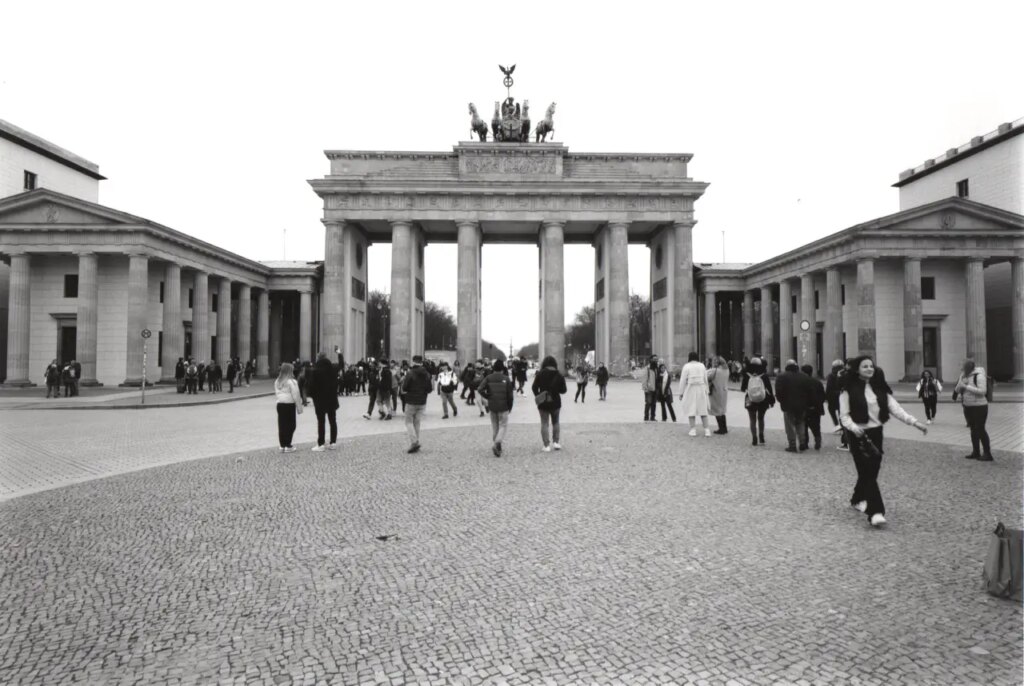
A short walk through the gate and we arrive at the Jewish memorial. I would like to have got onto one of the slabs and taken a shot from above and played around with the perspective but there is no chance of this. Quite strict security. It ruined my enjoyment and I did not feel especially creative so I did not linger. I think a bit more contrast and some shadow could have brought out more texture in the stones. This is one shot where the massive grey soft boxes have left me with an image which is flat.
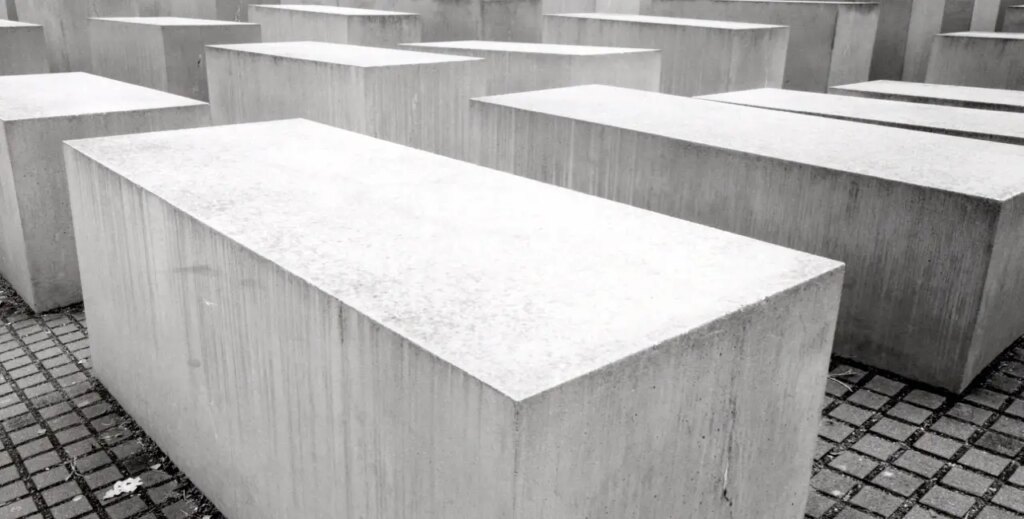
Heading back past the very expensive offices I saw four fire hydrants beautifully lit and standing to attention. Their placement is very practical for easy access. They are quite a distinctive feature of buildings in Berlin. Squares again divided into patterns by diagonal lines gives a nice 3 dimensional feel to the composition and a semi reflective glass backdrop adds interest as a mirror and a window.
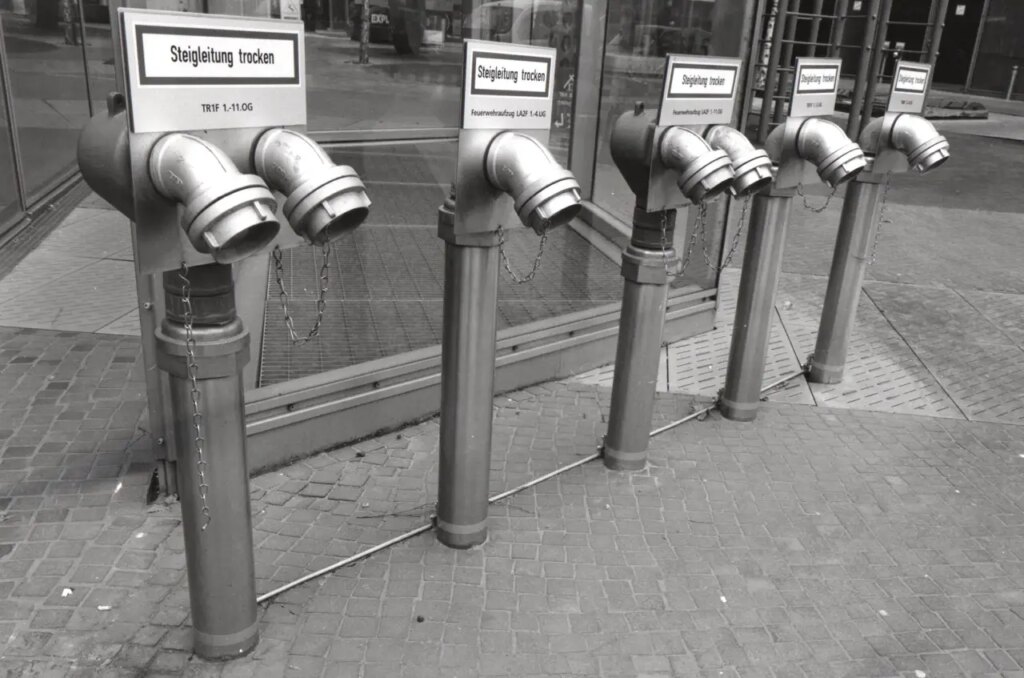
A stop off at Rosa-Luxenburg Platz provided an opportunity for a low light shot. I just about managed an aperture of F5.6 so sharpness is not amazing but the gloomy old style neon lights between the concrete roof joists is atmospheric and for the first time I have some shadows. It looks more like a 35mm shot!
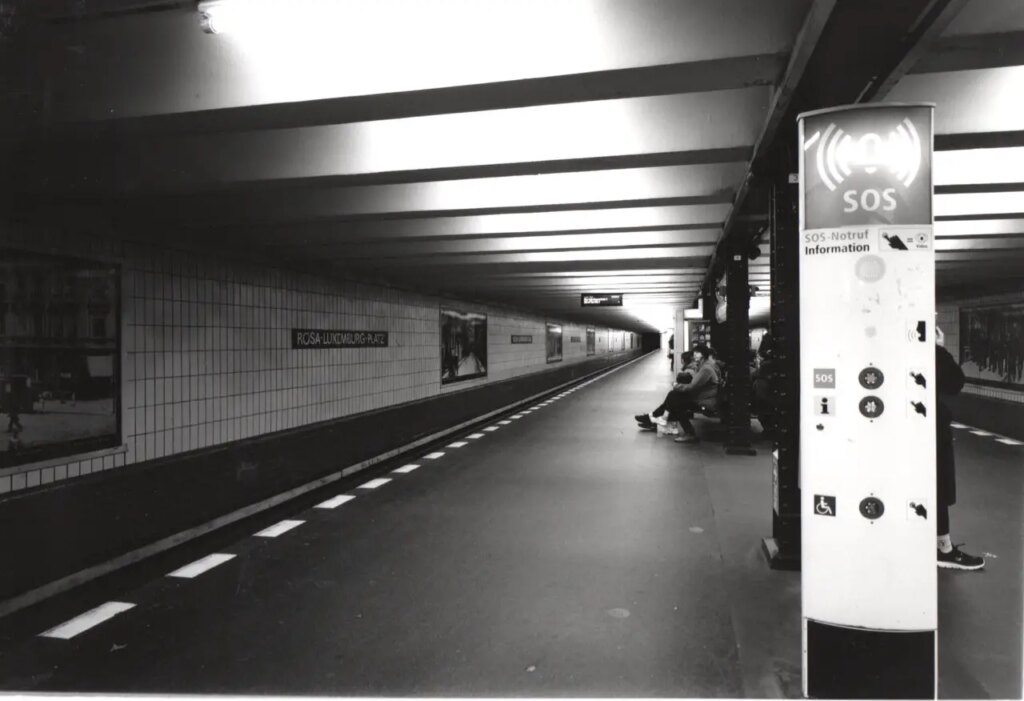
Exiting the station and a quick walk to Schönhauser Allee I am ready for a glorious shot of coffee at The Barn which is one of the cult coffee roasters. Delicious. I think this is probably here I would choose to meet my spy contacts.
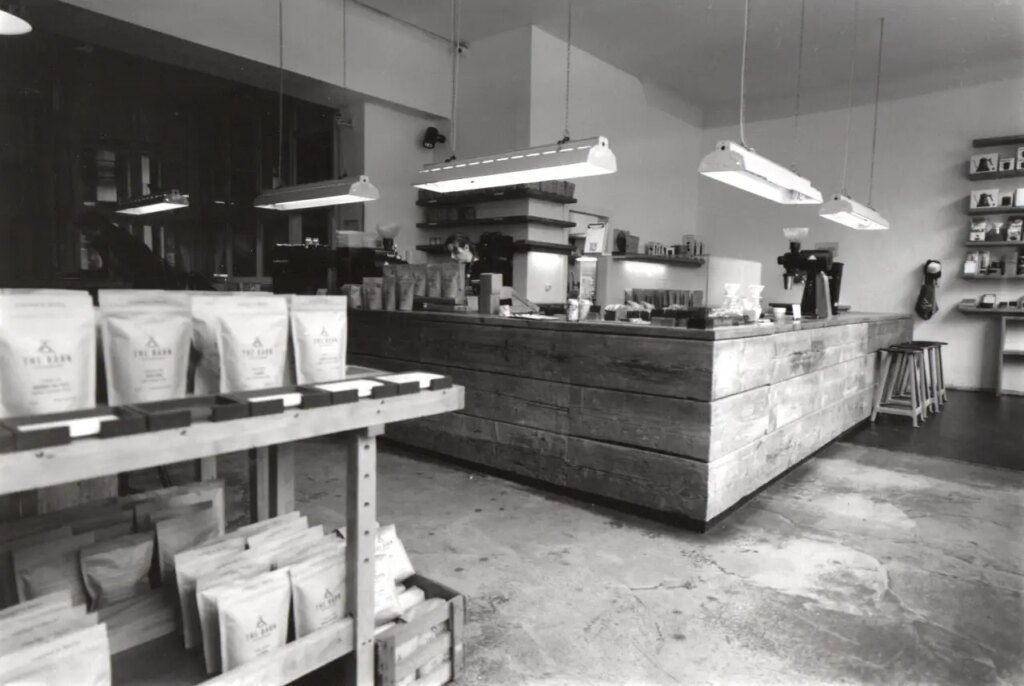
After a nice 90 minute flight back to the UK, I was home in enough time to bathe my films in Ilford DDX and hang them up to dry. Just enough time to make some contact prints and sleep on it. Four rolls of film.
Reflecting on the trip I think the planning, choice of film, and care in getting the images that I wanted has paid off. They are all very similar in exposure which hugely speeds up the printing. Care in composition means I can print full frame and there is very little need for dodging or burning to put a set of pictures together at A4 size. From here there is the more involved project of making my favourite images as detailed as possible for nice wall prints but I generally like to shuffle through the A4 shots for a while and live with them. Emphasis, contrast best paper are decisions to make gradually. Some images may be better with some cropping. The 6×9 format with a little off the top or bottom is halfway to a panorama.
Shooting with an Alpa is a bit like large format in some ways. The detail it captures can be stunning. Time taken trying to nail the image with one shot is a good strategy. No bracketing or multiple chimping. The capture process is relatively slow but if you get the finder level meter for shadows with black and white film you are most of the way there. Time spent at this stage can make the printing stage much faster and more effective.
I really like these images from a quick city visit. I feel very connected with the shots, the process and finally the initial printing and also looking forward to some archival quality big images. I hope you like them too but I don’t mind if you don’t. What I hope to demonstrate to you is my personal process and why it pleases me. Hoping your pictures make you as happy. If they do not, it is probably worth going back to basics and decide what it is that you want to achieve.
William Egglestone famously said “You can take a good picture of anything, and a bad one too!”. He is someone who made a deep freezer look interesting. Who am I to disagree?
Richard Marks
Share this post:
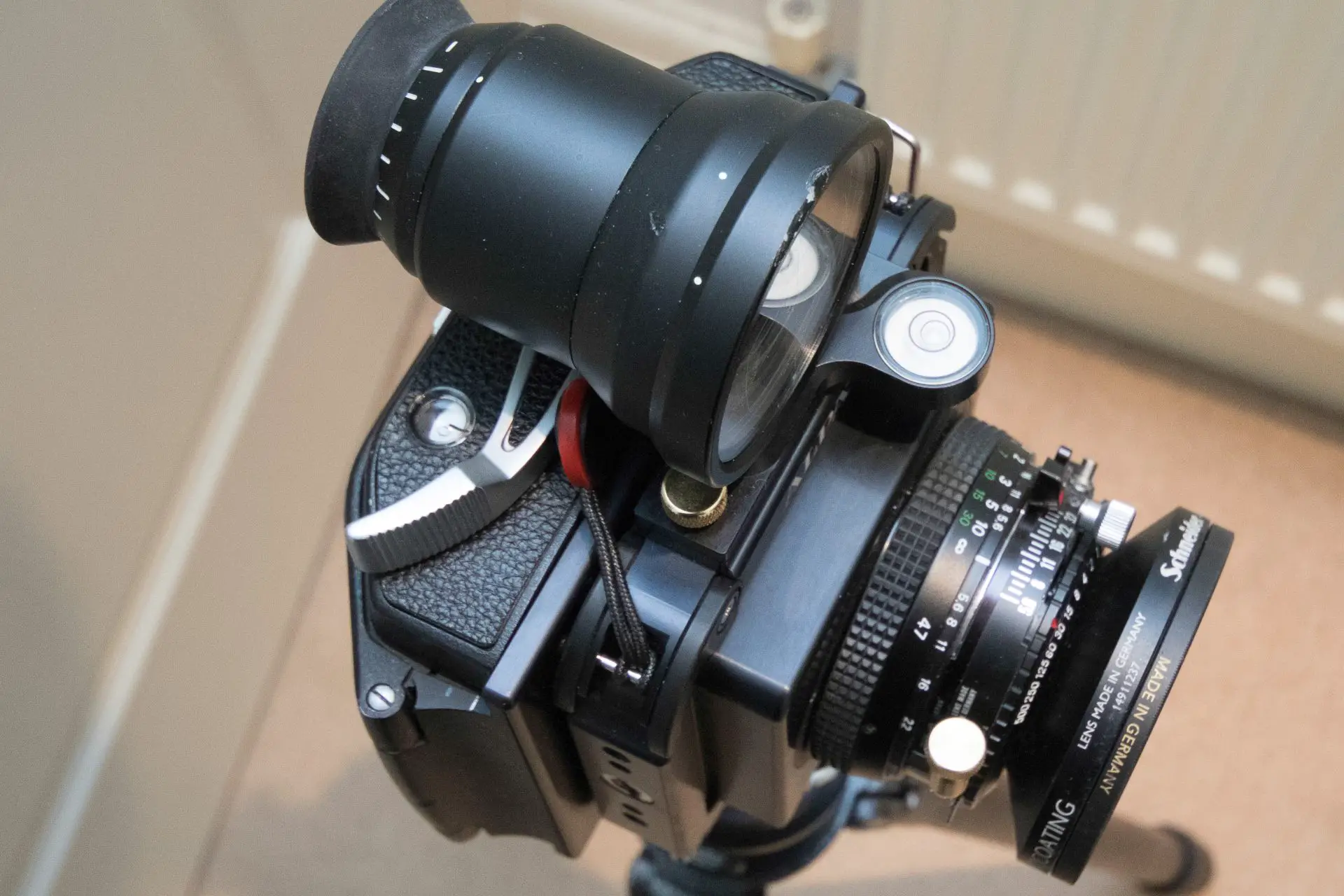








Comments
Thorsten Wulff on Alpa 12TC and some Berlin Street Photography
Comment posted: 11/04/2023
Hello from Berlin ;))
/thorsten
Comment posted: 11/04/2023
Tom Aspin on Alpa 12TC and some Berlin Street Photography
Comment posted: 11/04/2023
A nice set of images.
I used to be a frequent visitor Berlin, and if you're planning to go back I can certainly recommend going up to the top of the Reichstag, as the inside of the glass dome, and the views from the top are well worth the effort. Last time I checked it was still free to go in.
The inside of the Sony Centre is also worth a visit, due to the fairly spectacular roof structure
Tom
Comment posted: 11/04/2023
Bill White on Alpa 12TC and some Berlin Street Photography
Comment posted: 11/04/2023
Comment posted: 11/04/2023
Michael Jones on Alpa 12TC and some Berlin Street Photography
Comment posted: 12/04/2023
Comment posted: 12/04/2023